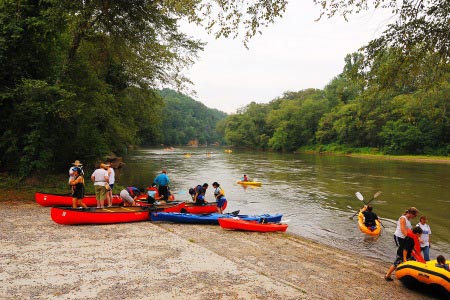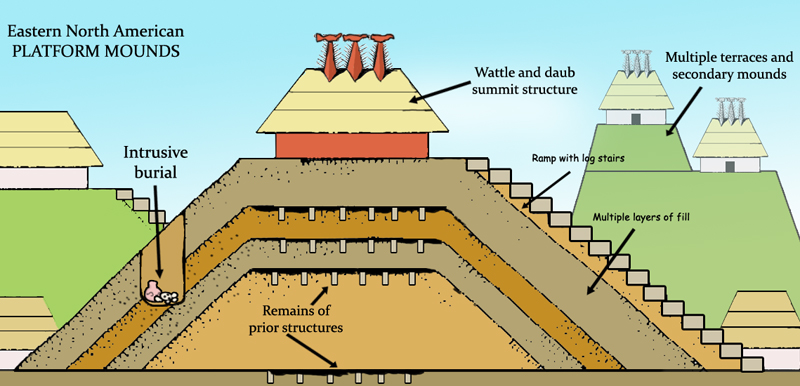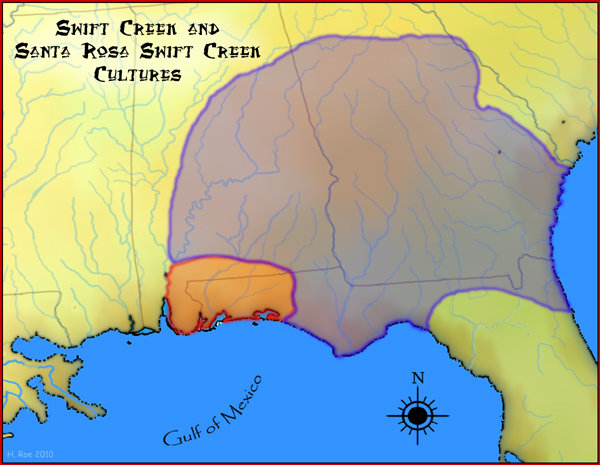|
Mandeville Site
The Mandeville site ( 9CY1) is an archaeological site in Clay County in southwest Georgia in the United States. The site now lies under the Walter F. George Reservoir, which is a part of the Chattahoochee River basin. History The first occupations of the site were a village settlement during the Deptford period. Occupation of the site and the construction of two mounds continue into the Middle Woodland period. Ceramic evidence also dates occupation to the Early Swift Creek culture. The final layer of Mound A indicates it was converted to a platform mound typical of the Mississippian period. Excavations The site was first visited by Clarence B. Moore at the turn of the century. He tested the site but did not conduct any excavations due to negative results. The site was visited by a field party from the University of Georgia in 1950. Some minor surface excavations were conducted. Thorough excavations on the site were conducted during 1959-1960 by Arthur Kelly, James H. Kellar a ... [...More Info...] [...Related Items...] OR: [Wikipedia] [Google] [Baidu] |
Clay County, Georgia
Clay County is a county located in the southwestern part of the U.S. state of Georgia. As of the 2020 census, the population was 2,848, making it the fourth-least populous county in Georgia. The county seat is Fort Gaines. History This area was historically occupied by the Creek Indians until Indian Removal in the 1830s. European Americans pushed them out and developed the land for cotton, bringing in thousands of African slaves to work the land. The county is named in honor of Henry Clay, famous American statesman, member of the United States Senate from Kentucky and United States Secretary of State in the 19th century. Part of the Black Belt geological formation of Georgia, prior to the American Civil War the county's chief commodity crop was cotton, cultivated and processed by farmers and African-American slaves. After the war, the economy continued to be agricultural, but timber was also harvested. Clay was created by a February 16, 1854, act of the Georgia General Assem ... [...More Info...] [...Related Items...] OR: [Wikipedia] [Google] [Baidu] |
Chattahoochee River
The Chattahoochee River forms the southern half of the Alabama and Georgia border, as well as a portion of the Florida - Georgia border. It is a tributary of the Apalachicola River, a relatively short river formed by the confluence of the Chattahoochee and Flint Flint, occasionally flintstone, is a sedimentary cryptocrystalline form of the mineral quartz, categorized as the variety of chert that occurs in chalk or marly limestone. Flint was widely used historically to make stone tools and start fir ... rivers and emptying from Florida into Apalachicola Bay in the Gulf of Mexico. The Chattahoochee River is about long. The Chattahoochee, Flint, and Apalachicola rivers together make up the Apalachicola–Chattahoochee–Flint River Basin (ACF River Basin). The Chattahoochee makes up the largest part of the ACF's drainage basin. Course The River source, source of the Chattahoochee River is located in Jacks Gap at the southeastern foot of Jacks Knob, in the very southeaste ... [...More Info...] [...Related Items...] OR: [Wikipedia] [Google] [Baidu] |
Dyar Site
The Dyar site ( 9GE5) is an archaeological site in Greene County, Georgia, in the north central Piedmont physiographical region. The site covers an area of 2.5 hectares. It was inhabited almost continuously from 1100 to 1600 by a local variation of the Mississippian culture known as the South Appalachian Mississippian culture. Although submerged under Lake Oconee, the site is still important as one of the first explorations of a large Mississippian culture mound. The Dyar site is thought to have been one of the principal towns of the paramount chiefdom of Ocute, perhaps Cofaqui. Site description The platform mound located at the site was described in 1975 as being in the shape of a truncated cone approximately high and with a base in diameter. On the eastern edge of the mound in the central area of the site was a plaza surrounded by domestic structures making up an oval shaped village of 2.13 hectares. Mound Platform mounds are built up in a series of stages that can span ge ... [...More Info...] [...Related Items...] OR: [Wikipedia] [Google] [Baidu] |
List Of Mississippian Sites
This is a list of Mississippian sites. The Mississippian culture was a mound-building Native American culture that flourished in what is now the Midwestern, inland-Eastern, and Southeastern United States from approximately 800 CE to 1500 CE, varying regionally. Its core area, along the Mississippi River and its major tributaries, stretched from sites such as Cahokia in modern Illinois, the largest of all the Mississippian sites, to Mound Bottom in Tennessee, to the Winterville site in the state of Mississippi. The typical form were earthwork platform mounds, with flat tops, often the sites for temples or elite residences. Other mounds were built in conical or ridge-top forms. The culture reached peoples in settlements across the continent: Temple mound complexes were constructed also in areas ranging from Aztalan in Wisconsin to Crystal River in Florida, and from Fort Ancient, now in Ohio, to Spiro in Oklahoma. Mississippian cultural influences extended as far north and w ... [...More Info...] [...Related Items...] OR: [Wikipedia] [Google] [Baidu] |
Arthur Randolph Kelly
Arthur Randolph Kelly (October 27, 1900 – November 4, 1979) was an American professional archaeologist. He made numerous contributions to archeology in Georgia, which began with directing excavations at the Macon Plateau Site in 1933, part of the federal archeology program that provided jobs while undertaking studies of important sites. During his career, he also worked at the Etowah Mound and Village site, Lamar Mounds, the Lake Douglas Mound, the Oliver and Walter F. George River Basin surveys, the Estatoe Mound, the Chauga Mound, and the Bell Field Mound, among others in Georgia. After completing his graduate education with master's and doctoral degrees at Harvard University, Kelly had a career spanning academic service, and professional excavations under the Smithsonian Institution and other organizations. He also directed operations at national monuments for the National Park Service and served as its chief archeologist for several years. In 1947 he was selected by Univ ... [...More Info...] [...Related Items...] OR: [Wikipedia] [Google] [Baidu] |
University Of Georgia
, mottoeng = "To teach, to serve, and to inquire into the nature of things.""To serve" was later added to the motto without changing the seal; the Latin motto directly translates as "To teach and to inquire into the nature of things." , established = , endowment = $1.8 billion (2021)As of June 30, 2021. , type = Public flagship land-grant research university , parent = University System of Georgia , accreditation = SACS , academic_affiliation = , president = Jere W. Morehead , provost = S. Jack Hu , city = Athens , state=Georgia , country = United States , coordinates = , faculty = 3,119 , students = 40,118 (fall 2021) , undergrad = 30,166 (fall 2021) , postgrad = 9,952 (fall 2021) , free_label2 = Newspaper , free2 = '' The Red & Black'' , campus = Midsize city / College town , campus_size = (main campus) (total) , colors = , sports_nickname = Bulldogs , sporting_affiliations = NCAA Division I FBS – SEC , mascot = Uga X (live English Bulldo ... [...More Info...] [...Related Items...] OR: [Wikipedia] [Google] [Baidu] |
Mississippian Culture
The Mississippian culture was a Native Americans in the United States, Native American civilization that flourished in what is now the Midwestern United States, Midwestern, Eastern United States, Eastern, and Southeastern United States from approximately 800 CE to 1600 CE, varying regionally. It was known for building large, earthen platform mounds, and often other shaped mounds as well. It was composed of a series of urban settlements and satellite villages linked together by loose trading networks. The largest city was Cahokia, believed to be a major religious center located in what is present-day southern Illinois. The Mississippian way of life began to develop in the Mississippi River Valley (for which it is named). Cultures in the tributary Tennessee River Valley may have also begun to develop Mississippian characteristics at this point. Almost all dated Mississippian sites predate 1539–1540 (when Hernando de Soto explored the area), with notable exceptions being Natchez p ... [...More Info...] [...Related Items...] OR: [Wikipedia] [Google] [Baidu] |
Swift Creek Culture
The Swift Creek culture was a Middle Woodland period archaeological culture in the Southeastern Woodlands of North America, dating to around 100-800 CE. It occupied the areas now part of Georgia, Alabama, Florida, South Carolina, and Tennessee. In Florida, Swift Creek ceremonial practices and burial complexes are referred to technically as the Yent-Green Point complex. The Swift Creek culture was contemporaneous with and interacted with the Hopewell culture; Swift Creek is often described as "Hopewellian." The type site for the Swift Creek culture was the Swift Creek mound site, which was located in Bibb County, Georgia. The Leake Mounds are another significant Swift Creek Culture site in Georgia. Swift Creek peoples practiced mound-building but were generally non-sedentary. Their sustenance resulted from hunting, gathering/collecting, and fishing. Swift Creek are characterized by earthenware pottery with complicated stamped designs, involving mostly curvilinear elements. Examples ... [...More Info...] [...Related Items...] OR: [Wikipedia] [Google] [Baidu] |
Walter F
Walter may refer to: People * Walter (name), both a surname and a given name * Little Walter, American blues harmonica player Marion Walter Jacobs (1930–1968) * Gunther (wrestler), Austrian professional wrestler and trainer Walter Hahn (born 1987), who previously wrestled as "Walter" * Walter, standard author abbreviation for Thomas Walter (botanist) ( – 1789) Companies * American Chocolate, later called Walter, an American automobile manufactured from 1902 to 1906 * Walter Energy, a metallurgical coal producer for the global steel industry * Walter Aircraft Engines, Czech manufacturer of aero-engines Films and television * ''Walter'' (1982 film), a British television drama film * Walter Vetrivel, a 1993 Tamil crime drama film * ''Walter'' (2014 film), a British television crime drama * ''Walter'' (2015 film), an American comedy-drama film * ''Walter'' (2020 film), an Indian crime drama film * ''W*A*L*T*E*R'', a 1984 pilot for a spin-off of the TV series ''M*A*S*H'' * ''W ... [...More Info...] [...Related Items...] OR: [Wikipedia] [Google] [Baidu] |
Deptford Culture
The Deptford culture (800 Current Era, BCE—700 CE) was an archaeological culture in southeastern North America characterized by the appearance of elaborate ceremonial complexes, increasing social and political complexity, Tumulus, mound burial, permanent settlements, population growth, and an increasing reliance on cultigens. Definition and range Deptford is named for the Deptford area near Savannah, Georgia. The culture is defined by the presence of sand-Temper (pottery), tempered pottery decorated with the impressions of carved wooden paddles that were pressed against the vessels before they were fired. The sand-tempering distinguishes Deptford ceramics from the fiber-tempered ceramics of the late-Archaic Stallings Island/St. Simons, Orange culture, Orange, and Norwood culture, Norwood cultures that preceded it. Other contemporary cultures of the southeastern United States also produced paddle decorated ceramics. The Deptford culture was oriented to the coast. From northern Ge ... [...More Info...] [...Related Items...] OR: [Wikipedia] [Google] [Baidu] |
Archaeological Site
An archaeological site is a place (or group of physical sites) in which evidence of past activity is preserved (either prehistoric or historic or contemporary), and which has been, or may be, investigated using the discipline of archaeology and represents a part of the archaeological record. Sites may range from those with few or no remains visible above ground, to buildings and other structures still in use. Beyond this, the definition and geographical extent of a "site" can vary widely, depending on the period studied and the theoretical approach of the archaeologist. Geographical extent It is almost invariably difficult to delimit a site. It is sometimes taken to indicate a settlement of some sort although the archaeologist must also define the limits of human activity around the settlement. Any episode of deposition such as a hoard or burial can form a site as well. Development-led archaeology undertaken as cultural resources management has the disadvantage (or the ben ... [...More Info...] [...Related Items...] OR: [Wikipedia] [Google] [Baidu] |
Smithsonian Trinomial
A Smithsonian trinomial (formally the Smithsonian Institution Trinomial System, abbreviated SITS) is a unique identifier assigned to archaeological sites in many states in the United States. They are composed of one or two digits coding for the state, typically two letters coding for the county or county-equivalent within the state, and one or more sequential digits representing the order in which the site was listed in that county. The Smithsonian Institution The Smithsonian Institution ( ), or simply the Smithsonian, is a group of museums and education and research centers, the largest such complex in the world, created by the U.S. government "for the increase and diffusion of knowledge". Founded ... developed the site number system in the 1930s and 1940s, but it no longer maintains the system. Trinomials are now assigned by the individual states. The 48 states then in the union were assigned numbers in alphabetical order. Alaska was assigned number 49 and Hawaii was assigne ... [...More Info...] [...Related Items...] OR: [Wikipedia] [Google] [Baidu] |






